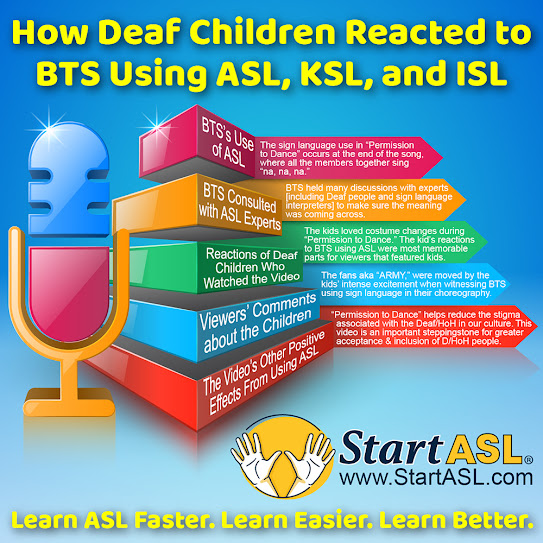The Response of Deaf Children to BTS Utilizing ASL, KSL, and ISL
South Korean boy band BTS’s use of sign language into their July 2021 “Permission to Dance” music video attained worldwide recognition. Specifically, the group was commended for incorporating Korean Sign Language (KSL), International Sign Language (ISL), and American Sign Language (ASL) within their performance. The particular video’s choreography features signs for the words “dance,” “peace,” and “enjoy.”
This video is set in a post-pandemic era, where the band members are viewed dancing in a number of locations including a laundromat, a sunny location, and a patio. The sign language use in “Permission to Dance” occurs near the end of the song, whereby all the members together sang “na, na, na.”
To make sure that the meaning of “Permission to Dance” was clear, BTS along with their team of choreographers paid added focus on the details within their signing. A representative of BTS’ entertainment company Big Hit Music said, “After choosing keywords and symbolic gestures, we turned that into choreography. And we went through a process of holding many discussions with experts [including Deaf people and sign language interpreters] to make sure the meaning was coming across.”
The experts the group consulted stressed the power of such expressions in doing sign language. As an example, the sign for “enjoy” also conveys “welcome.” So, to unambiguously correspond the lyric regarding “enjoy” to their Deaf and Hard-of-hearing fans, the band needed to express happiness in their faces.
Response of Deaf Children Who Viewed the Music Video
The YouTube channel Deaf BTS just recently uploaded a video of children’s responses to the “Permission to Dance” music video. In the past, the channel has published other videos where they have done sign language for various BTS songs. This time around, a group of Deaf children fluent in American Sign Language (ASL) were shown reacting towards the music video while sitting on the floor.
One particular girl was actually greatly surprised when she observed BTS member J-Hope performing in ASL, and shared an emotional reaction. She signed, “I’m stunned. That’s ASL ‘dance!’ They signed ‘dance.’ How’d they do that?” She added, “They signed ‘dance’! Cool. They signed ‘dance’ twice. Just like here in the US. I’m gonna pass out.” The enthusiastic girl then pretended to pass out by dramatically dropping forward on to the floor.
When the other kids also realized just what the band was doing, they couldn’t believe that BTS had utilized American Sign Language in their performance. One girl wondered about when the group members had learned ASL.
The Video’s Good Effects From Using ASL
By using sign language within their choreography the band gave the kids and numerous other Deaf or Hard of hearing (D/HoH) sign language users worldwide a sense of greater inclusion in mainstream culture. These types of considerate acts by celebrities and other public figures make members of the D/HoH community feel like they’re being seen and heard by the much larger community.
BTS’s usage of sign language is additionally elevating awareness of the D/HoH culture amongst hearing individuals. The fans were furthermore greatly astounded by the sign language incorporated into the “Permission to Dance” choreography.. One particular fan wrote on Twitter, “You know what’s cool? The motion that they were doing for ‘dance’ is the actual sign for ‘dance’ in American Sign Language.”
Such responses suggest that “Permission to Dance” can help to reduce the stigma with regards to the Deaf and Hard of hearing within our culture. Additionally, they deliver hope to the D/HoH community by exhibiting that hearing people are willing to recognize them and their language as equals. In this way, the video is an essential steppingstone toward a more significant acceptance and inclusion of D/HoH people in mainstream society.



Comments
Post a Comment